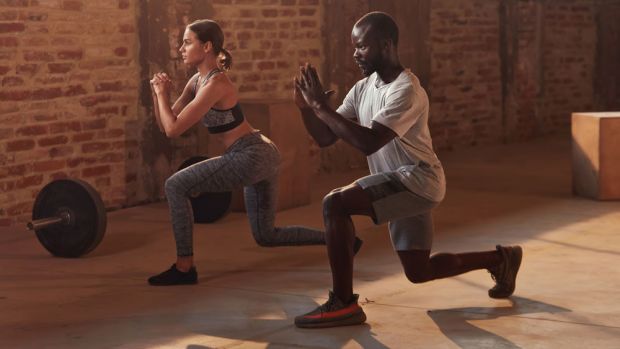
Timing matters when you’re lifting weights. It’s not just the load on the bar, nor the reps you rack up. The time your muscles spend under tension and how dynamically they work can have a huge impact on how strong they get, how big they grow and how quickly your fitness improves. To turn this idea to your advantage you need to understand tempo.
Tempo training applies a set speed to the exercises you perform. If you’ve hit a wall with your strength workouts, slowing your tempo can help you break through plateaus. Or if you’re trying to improve your speed for sports, increasing your tempo in training can make you more explosive on the pitch.
The Benefits Of Tempo Training
Generally speaking, using tempo training in the right way will help you become more athletic and less injury-prone, while giving you a broader understanding of the training effect. “Knowing how to use tempo when exercising has a host of benefits,” says Harvey Lawton, PT and founder of The Movement Blueprint. “Pausing during a lift can improve positional awareness and balance, while slowing it down can fix weaknesses, and speeding it up can train for power and boost reaction time for sports.”
The Downsides Of Tempo Training
Delayed onset muscle soreness, or DOMS, is probably the biggest one. This can happen in the 24 to 48 hours after hammering slow eccentric (lowering) movements in your workouts. “During the eccentric phase of a movement pattern more muscle damage occurs, therefore heavy eccentric training may result in increased muscle soreness,” says Lawton. “But this is far outweighed by the strength and performance benefits you can gain from tempo training.”
Is Tempo Training Suitable For Beginners?
One hundred percent, says Lawton. “Beginners can use slower movement patterns to train efficient mechanics and increase strength. For more advanced athletes, experiment with different tempos to increase resilience across all lifts.”
When squatting, for example, Lawton suggests starting with a tempo of 3211 (see below), then changing to 2111 as the weight increases. “On the whole,” Lawton says, “the only difference between beginner and advanced tempo training should be the load or choice of exercise.”
Decoding Tempo Training Numbers
Along with sets, reps or time, and rest, you’ll find tempo written out as four numbers (although one of the digits might be an X).
Sign up for workout ideas, training advice, reviews of the latest gear and more.
- The first number is the time in seconds to perform the eccentric or lowering part of the move.
- The second number is the time to pause at the bottom of the rep.
- The third is the time to perform the concentric or most dynamic part of the move, usually the lift.
- The fourth number is the time to pause at the top of the rep.
- An X indicates that part of the lift should be performed explosively.
For example, the tempo for a dynamic box jump could look like this:
11X1 – one second down, one second to pause at the bottom, an explosive jump, one second to pause at the top.
For a biceps curl it could look like this:
4111 – four seconds down, one second at the bottom, one second up, one second at the top.
The quirk that might trip beginners up is when the eccentric part of the exercise isn’t typically done as the first movement. For instance, with the tempo 4111 for a biceps curl the lift movement comes first, but corresponds to the third number. If in doubt look up the eccentric part of each exercise.
See related
Sample Tempo Workout
Lawton has devised a full-body workout that draws on the guiding principles of tempo training. It includes isometric holds to prime your muscles and joints for what’s to come, dynamic plyometrics for explosive power and slow eccentric lifts for increased size and strength.
Remember, the tempo for each exercise is indicated with four numbers unless it’s an isometric hold. For the eccentric pull-up, 3111 means lower for three seconds, pause for one, lift yourself up to the bar for one, pause for one. For the broad jump, 11X1 means lower for one second, pause for one, explode up powerfully, then pause on your landing for one.
Warm-Up
1 Isometric split squat

Sets 1 Time 20sec each side Tempo n/a Rest 0sec
Stand with one foot in front of you and the other behind you, with enough width between the two so you can maintain your balance. Keeping your torso upright, lower until both knees are bent at 90°. Engage your core, glutes and thighs and hold this position for 20 seconds to fire up your lower-body muscles.
2 Side plank pause

Sets 1 Reps 5 Tempo 1112 Rest 0sec
Lie on your side, supporting yourself on your forearm and one foot stacked on top of the other. Drive your hips up, supporting your weight with your forearm and keeping your shoulders in line. Pause for two seconds, then lower your hip towards the floor and repeat.
3 Eccentric pull-up

Sets 1 Reps 5 Tempo 3111 Rest 0 sec
Hold a pull-up bar with your hands double-shoulder width apart, using an overhand grip. Retract your shoulder blades to engage your upper-back muscles and pull your chest to the bar. Pause for one second, then lower for three seconds and repeat.
Plyometric Primers
1 Kettlebell swing

Sets 1 Reps 20 Tempo 11X1 Rest 30sec
Use a medium weight. Position the kettlebell on the floor a little in front of you. Hinge at your hips, push your bum back and grasp the kettlebell handle in both hands. Pull the weight back between your legs, then drive your hips forwards powerfully as you stand up, allowing the kettlebell to rise to eye level. Let the weight swing back between your legs and repeat.
2 Broad jump
Sets 1 Reps 3 Tempo 11X1 Rest 30sec
The goal here is to take a big jump forwards and land under control. Stand with your feet hip-width apart and your arms extended above your head, swing your arms down as you lower into a quarter squat, then explode forwards, swinging your arms forwards to help generate momentum. Bend your knees as you land to soften the impact and repeat into the next rep.
Eccentric Strength Phase
1 Barbell back squat

Sets 4 Reps 8-6-4-2 Tempo 3121-3121-2111-2111 Rest 60sec
For the first set, use a tempo of 3121 (lowering for three seconds, driving up for two) and complete eight reps. For the second use the same tempo for six reps. For the third and fourth, use a tempo of 2111 and complete four and two reps respectively. Increase the load slightly with each set if possible.
Position the bar across your upper back and grip firmly as you drive up to remove it from the rack. Stand with your feet shoulder-width apart, keep your chest up and core engaged, then lower until your thighs are parallel to the floor, keeping your knees wide apart.
2 Neutral grip pull-up

Sets 4 Reps 5 Tempo 2111 Rest 60sec
Use the handles so your palms face each other if possible. As with the earlier pull-up, retract your shoulder blades to engage your upper back muscles, and pull your chest to the bar. Pause for one second, then lower for two seconds and repeat.
3 Incline bench press

Sets 4 Reps 8-6-4-2 Tempo 3121-3121-2111-2111 Rest 60sec
Follow the same rep and tempo pattern as with the barbell back squat, increasing the load slightly with each set if possible. You can use either a barbell or dumbbells for this chest move. Set a bench to a 45° angle and keep your feet flat on the floor as you drive the weight straight up for two seconds and lower for three in the first two sets, then drive up for one and lower in two for the final sets.
4 Bulgarian split squat

Sets 4 Reps 8-12 each side Tempo 2111 Rest 60sec
Face away from a bench and rest the top of one foot on the bench, supporting your weight on the standing leg. Holding a dumbbell or kettlebell in a goblet position against your chest, bend your front leg to lower your back knee until just off the floor, keeping your torso upright. Lower for a count of two seconds, pause for one, drive up for one, pause for one and repeat. Perform equal reps on both sides before resting.
Aerobic Capacity Finisher
1 Tabata sprints

Sets 8 Time 20sec Tempo n/a Rest 10sec
Lawton concludes this session with a four-minute Tabata finisher on an assault bike, stationary bike or rowing machine. The tempo: all-out effort. Aim to work near your maximum for 20 seconds, then rest for 10 seconds. Repeat eight times, aiming to keep the intensity of each effort consistent. Don’t blame us. Blame Harvey.

Sam Rider is an experienced freelance journalist, specialising in health, fitness and wellness. For over a decade he's reported on Olympic Games, CrossFit Games and World Cups, and quizzed luminaries of elite sport, nutrition and strength and conditioning. Sam is also a REPS level 3 qualified personal trainer, online coach and founder of Your Daily Fix. Sam is also Coach’s designated reviewer of massage guns and fitness mirrors.
